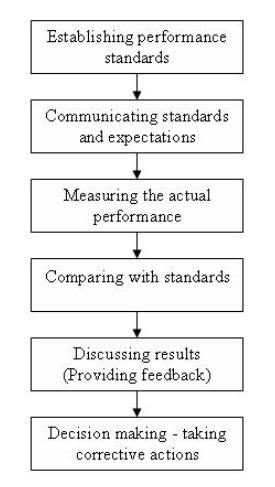Chapter: Principles of Management : Organizing
Performance Appraisal
PERFORMANCE APPRAISAL
Performance appraisal is the process of obtaining, analyzing and recording information about the relative worth of an employee. The focus of the performance appraisal is
measuring and improving the actual performance of the employee and also the
future potential of the employee. Its aim is to measure what an employee does.
Objectives
of Performance appraisal:
To review
the performance of the employees over a given period of time.
To judge
the gap between the actual and the desired performance.
To help
the management in exercising organizational control.
Helps to
strengthen the relationship and communication between superior – subordinates
and management – employees.
To
diagnose the strengths and weaknesses of the individuals so as to identify the
training and development needs of the future.
To provide
feedback to the employees regarding their past performance.
Provide information to assist in the other personal decisions in the
organization.
Provide
clarity of the expectations and responsibilities of the functions to be
performed by the employees.
To judge
the effectiveness of the other human resource functions of the organization
such as recruitment, selection, training and development.
To reduce
the grievances of the employees.
Process of performance appraisal:

a) Establishing performance standards:
The first step in the process of
performance appraisal is the setting up of the standards which will be used
to as the base to compare the actual performance of the employees. This step
requires setting the criteria to judge the performance of the employees as
successful or unsuccessful and the degrees of their contribution to the
organizational goals and objectives. The standards set should be clear, easily
understandable and in measurable terms.
In case
the performance of the employee cannot be measured, great care should be taken
to describe the standards.
b) Communicating the standards:
After establishing the standards, it is the responsibility of the
management to communicate the standards to all the employees of the
organization.
The
employees should be informed and the standards should be clearly explained to
the. This will help them to understand their roles and to know what exactly is
expected from them. The standards should also be communicated to the appraisers
or the evaluators and if required, the standards can also be modified at this
stage itself according to the relevant feedback from the employees or the
evaluators.
c) Measuring the actual performance:
The most
difficult part of the Performance appraisal process is measuring the actual
performance of the employees that is the work done by the employees during the
specified period of time. It is a continuous process which involves monitoring
the performance throughout the year. This stage requires the careful selection
of the appropriate techniques of measurement, taking care that personal bias
does not affect the outcome of the process and providing assistance rather than
interfering in an employees work.
d) Comparing the actual with the desired
performance:
The actual performance is compared with the desired or the standard
performance. The comparison tells the deviations in the performance of the
employees from the standards set. The result can show the actual performance
being more than the desired performance or, the actual performance being less
than the desired performance depicting a negative deviation in the
organizational performance. It includes recalling, evaluating and analysis of
data related to the employees’ performance.
e) Discussing results:
The result of the appraisal is communicated
and discussed with the employees on one-to-one basis. The focus of this
discussion is on communication and listening. The results, the problems and the
possible solutions are discussed with the aim of problem solving and reaching
consensus. The feedback should be given with a positive attitude as this can
have an effect on the employees’ future performance. The purpose of the meeting
should be to solve the problems faced and motivate the employees to perform
better.
f) Decision making:
The last step of the process is to take decisions which can be taken
either to improve the performance of the employees, take the required
corrective actions, or the related HR decisions like rewards, promotions,
demotions, transfers etc.
Related Topics